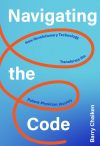 Dr. Halamka is the President of the Mayo Clinic Platform and former CIO at Beth Israel Deaconess Medical Center and the Harvard Medical School
Dr. Halamka is the President of the Mayo Clinic Platform and former CIO at Beth Israel Deaconess Medical Center and the Harvard Medical School
In my 40 years in the healthcare IT industry, I’ve written a great deal about disruption. I’ve described the perfect storm when the government, academia and industry align to adopt a new technology.
I’ve examined the technologies, policies, and psychology of innovation dissemination. If you strip away the bits and bytes, the hype cycle, and the regulatory compliance drivers, the best revolutions in healthcare IT happen with successful change management.
In this book, Dr. Barry Chaiken presents all the tools that clinicians, administrators, and businesspeople need to transform their healthcare organizations with the strategic use of technology.
He does not focus on any one emerging technology—this is not a treatise about cloud, mobile, internet of things, AI, or blockchain. He focuses on the principles that enable organizational transformation regardless of the tech stack.
When I was a graduate student at MIT in the early 1990s, Professor Hal Abelson taught me that although technology evolves rapidly, engineering concepts stay constant – such as creating systems with modular components that are easily swapped/replaced. It’s critical that a book about revolutionary healthcare IT focus on change and the management of change, rather than adoption of any one new product.
Dr. Chaiken’s approach is a mixture of core management ideas taken from the past 100 years of leadership literature, with the healthcare domain’s specific goals of quality, safety, and efficiency. The book presents a “bedside consultation” in each chapter to ensure the reader has the historical and situational background of the key concepts that are foundational to leading change in healthcare. Chapters are interspersed with interviews/case studies that provide real-world insights from those who have experience in digitizing healthcare.
You can be assured that this is not a text about programming, economic modeling, or navigating regulations. It’s a book that synthesizes decades of experience in healthcare leadership into five thematically related sections. The book progresses from the current state of healthcare worldwide to the 21st-century healthcare we need and want.
Along the journey, the reader is treated to the best thinking from Peter Drucker, Avedis Donabedian, and many others.
One of the most remarkable aspects of the book is its multi-disciplinary content. By bringing together such diverse topics as the foundational medical record thinking of Larry Weed, stories about Elon Musk, and even quotes from “Star Trek,” the book is extremely readable.
When I write about change, I reflect on personal experiences in my life that have gone well and others that have required me to pick myself up and try a new approach. I tell my students and colleagues that I’ve made enough mistakes as an IT leader that I know what not to do. I have a sense of guardrails and risk mitigations. I’ve participated in numerous Harvard Business School cases that highlight my missteps so that others will not repeat them. In this book, Dr. Chaiken synthesizes his own experiences and the wisdom of countless past/current leaders so the reader is handed a roadmap to successful navigation of the change ahead.
Every week at Mayo Clinic I write a “weekly update,” summarizing my meetings and progress into a thematic context. I recently summarized my experience leading disruption in healthcare information technology as “navigating without a map.” You know where you want to go, but don’t know how to get there. In such situations, you must rely on guiding principles and experience. Think of Navigating the Code: How Revolutionary Technology Transforms the Patient-Physician Journey as providing both. Armed with the experience of those who have come before (the literal translation of the word “sensei”) and principles that put the patient first, the reader has the necessary tools to lead the journey ahead.

Recent Comments